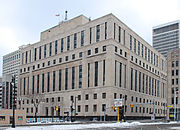| Theodore Levin United States Courthouse | |
|---|---|
 | |
 | |
| General information | |
| Type | courthouse |
| Location | 231 West Lafayette Boulevard Detroit, Michigan |
| Construction started | 1932 |
| Completed | 1934 |
| Technical details | |
| Floor count | 10 |
| Design and construction | |
| Architect(s) | Branson V. Gamber and Robert O. Derrick |
Theodore Levin United States Courthouse | |
| Coordinates | 42°19′49″N 83°2′58.5″W / 42.33028°N 83.049583°W |
| Part of | Detroit Financial District (ID09001067) |
| NRHP reference No. | 100002381 |
| Significant dates | |
| Added to NRHP | April 27, 2018 |
| Designated CP | December 14, 2009 |
The Theodore Levin United States Courthouse (also known as the Detroit Federal Building) is a large high-rise courthouse and office building located at 231 West Lafayette Boulevard in downtown Detroit, Michigan. The structure occupies an entire block, girdled by Shelby Street (east), Washington Boulevard (west), West Fort Street (south), and West Lafayette Boulevard (north). It is the seat of the United States District Court for the Eastern District of Michigan. The building is named after the late Theodore Levin, a lawyer and United States district judge of the Eastern District, who served as Chief Judge from 1959 through 1967.
Construction began in 1932 and finished in 1934. It stands at 10 stories in height, with its top floor at 50 metres (150 feet) from the first floor entrance, with the roof being 56.1 metres, or 184 feet (56 m) in height from the top of the roof to the streets below. The building was designed in the Art Deco and art moderne styles of architecture, incorporating granite and limestone into the structure. The main façade is limestone, above a polished black stone.
Inside the building, there is an open-center court above the second floor. The building contains relief sculptures of eagles and emblems above the entrance, which symbolize the building's governmental function (as a courthouse).
The seventh floor contains the lavishly decorated, Romanesque style Chief Judge's Courtroom, one of the building's most notable features. At the request of Chief Judge Arthur Tuttle, the courtroom from the previous building (built in 1897) was disassembled and stored during construction, then reassembled in the new building.
